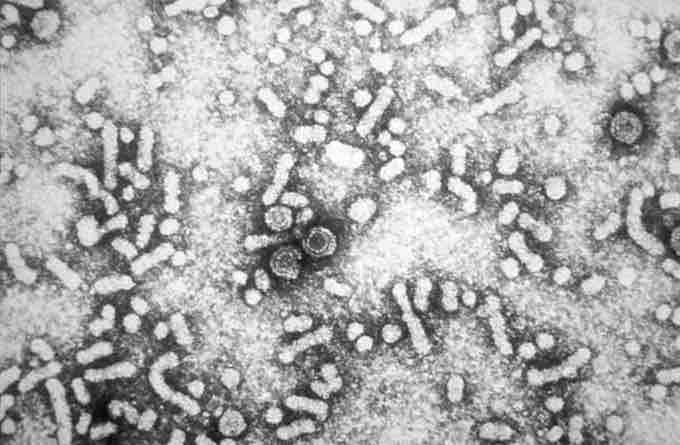Hepatitis is the inflammation of the liver. The condition can be self-limiting (healing on its own) or can progress to fibrosis (scarring) and cirrhosis.
Hepatitis may occur with limited or no symptoms, but often leads to jaundice, poor appetite, and malaise. Hepatitis is acute when it lasts less than six months and chronic when it persists longer. A group of viruses, known as the hepatitis viruses, cause most cases of hepatitis worldwide, but it can also be due to toxins, notably alcohol, certain medications, some industrial organic solvents, and plants.
Symptoms
The initial symptoms of hepatitis are nonspecific flu-like symptoms, common to almost all acute viral infections and may include malaise, muscle and joint aches, fever, nausea or vomiting, diarrhea, and headache. More specific symptoms, which can be present in acute hepatitis from any cause, are profound loss of appetite, aversion to smoking among smokers, dark urine, yellowing of the eyes and skin and abdominal discomfort. Physical findings are usually minimal, apart from jaundice and liver swelling. Some patients exhibit enlarged lymph nodes or enlargement of the spleen.

Jaundice
Jaundice, seen here as yellowing of the eyes, is often a symptom of hepatitis.
Acute Hepatitis
Acute viral hepatitis is more likely to be asymptomatic in younger people. Symptomatic individuals may present after convalescent stage of 7 to 10 days, with the total illness lasting 2 to 6 weeks.
A small proportion of people with acute hepatitis progress to acute liver failure, in which the liver is unable to clear harmful substances from the circulation, leading to confusion and coma due liver insufficiency, and unable to produce blood proteins, leading to peripheral edema and bleeding. This may become life-threatening and, occasionally, requires a liver transplant.
Chronic Hepatitis
Chronic hepatitis often leads to nonspecific symptoms, such as malaise, tiredness and weakness, and often causes no symptoms at all. It is commonly identified on blood tests performed either for screening or to evaluate nonspecific symptoms. The occurrence of jaundice indicates advanced liver damage. On physical examination, there may be enlargement of the liver.
Extensive damage and scarring of liver, known as cirrhosis, leads to weight loss, easy bruising and bleeding tendencies, peripheral edema and accumulation of ascites, or fluid in the abdominal cavity. Eventually, cirrhosis may lead to various complications, including esophageal varices, which are enlarged veins in the wall of the esophagus that can cause life-threatening bleeding; hepatic encephalopathy, which causes confusion and coma; and kidney dysfunction.
Diagnoses
A diagnosis of hepatitis is usually made by a combination of blood work and physical examination. When the liver is inflamed, levels of certain liver enzymes that are found in the blood will be elevated. If a patient has viral hepatitis, the presence of the virus can be detected in the blood. Patients with progressing liver damage will often display jaundice, or yellowing of the whites of the eyes and skin, and their livers will be visibly enlarged.
Causes
There are many causes of liver inflammation, or, hepatitis. The most common cause of acute hepatitis is infection with the Hepatitis B, C, or D viruses. Bacterial diseases can also cause liver inflammation, such as tuberculosis and tick-borne diseases.

Hepatitis B Virus
The hepatitis B virus is a common cause of liver inflammtion.
Non-infectious causes of hepatitis include alcohol, autoimmune conditions, drugs, circulatory insufficiency, metabolic diseases, pregnancy, and toxins.
Alcohol is a significant cause of hepatitis worldwide. Usually alcoholic hepatitis comes after a period of increased alcohol consumption. Alcoholic hepatitis is characterized by a variable constellation of symptoms, which may include feeling unwell, enlargement of the liver, development of fluid in the abdomen ascites, and a modest elevation of liver blood tests. Alcoholic hepatitis can vary from mild with only liver test elevation to severe liver inflammation with development of jaundice and liver failure.
Alcoholic hepatitis is distinct from cirrhosis caused by long-term alcohol consumption. Alcoholic hepatitis can occur in patients with chronic alcoholic liver disease and alcoholic cirrhosis. Alcoholic hepatitis by itself does not lead to cirrhosis, but cirrhosis is more common in patients with long-term alcohol consumption.
Treatment
Treatment of hepatitis typically involves treating the underlying condition that caused the inflammation.
In acute hepatitis caused by the hepatitis viruses, often, the liver inflammation will subside when the viral illness has subsided. Antiviral medications, such as interferon, can be used to treat the hepatitis viruses. There is currently a vaccination for Hepatitis B, but not for C or D. Similarly, hepatitis caused by a bacterial disease will typically resolve once the bacterial illness is treated with antibiotics.
For non-infectious causes of hepatitis, treatment of the underlying cause is necessary. For those with alcohol-induced hepatitis, cessation of drinking is recommended, as alcoholic hepatitis is often the beginning of more serious drinking-related liver disorders.